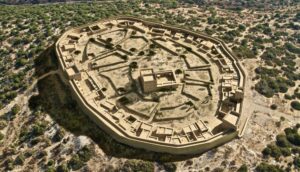
Khirbet Qeiyafa, in Israel, is located on the summit of a hill that borders the Elah Valley southwest of Jerusalem. This would have been a key strategic location in the biblical Kingdom of Judah, on the main road from Philistia and the coastal plain to Jerusalem and Hebron in the hill country. Even prior to excavation, visitors to Khirbet Qeiyafa could discern a massive city wall, 2–3 m in height, encompassing the summit of the hill. This city wall demarcates an area of 2.3 hectares with a total length of ca. 700 m. Due to the local topography, only the external face of the wall is exposed, the inner part buried under archaeological remains. The base of the wall is composed of cyclopean stones, some weighing 4–5 tons, while its upper part is built with medium-sized stones. Two city gates were already located prior to their excavation, one in the south and one in the west (Figs. 1–3).
____________________________________
This article is available to Premium members of Popular Archaeology.
Become a member or upgrade to a Premium membership: REGISTER HERE.
Member Login:




